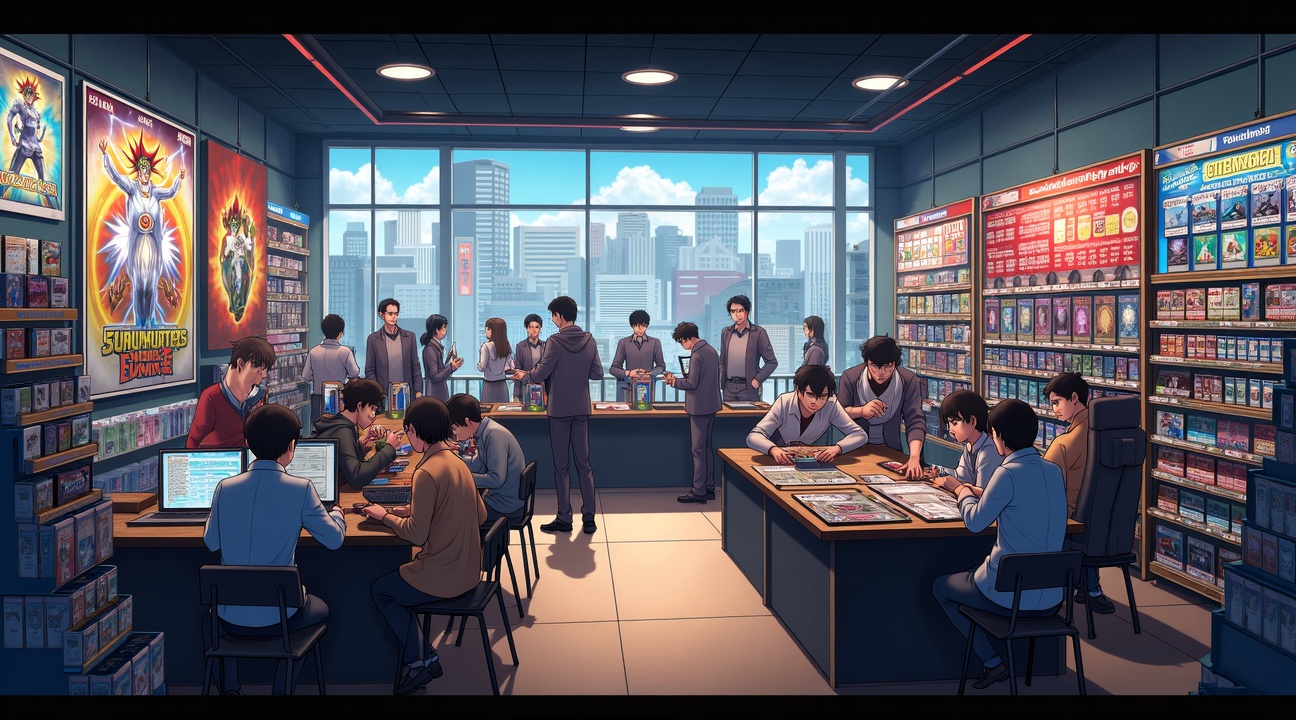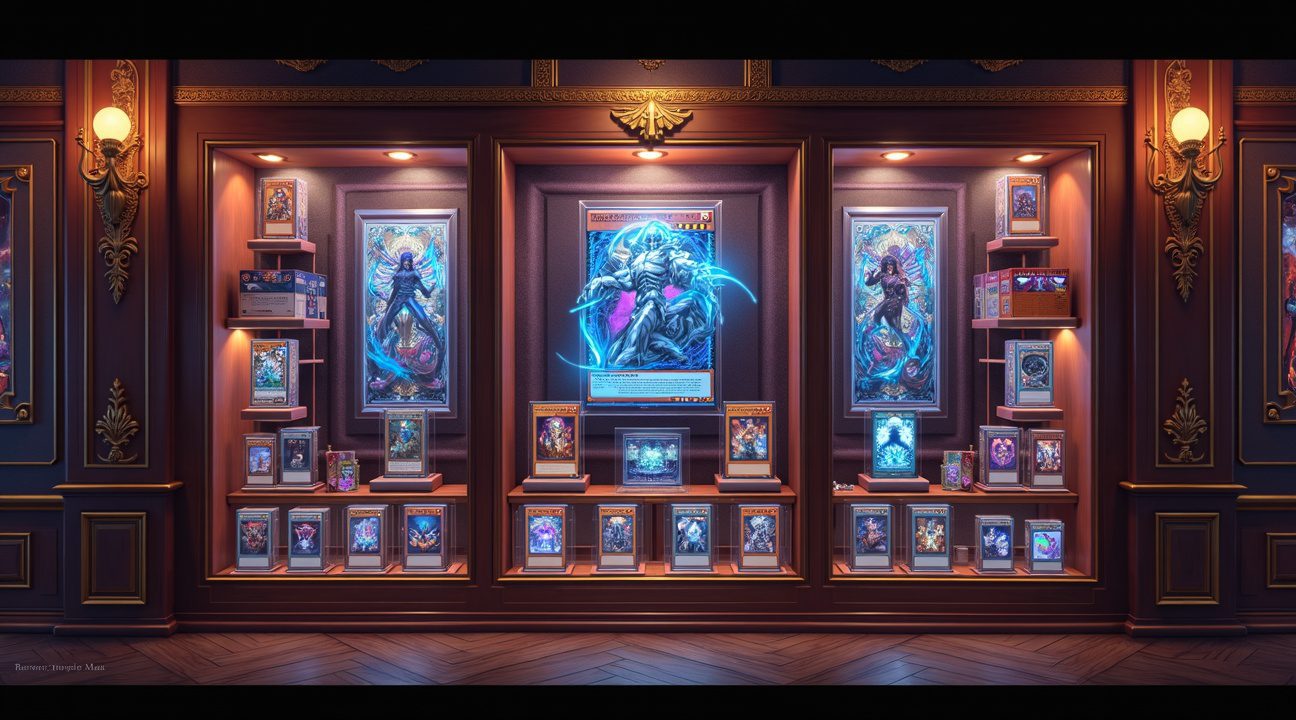The Yu-Gi-Oh! franchise has reached an impressive valuation of $5.42 billion as of July 2025, placing it among the globe’s top 30 highest-grossing media franchises through its wide-ranging portfolio that includes trading cards, video games, and global merchandise.
Key Takeaways
- Franchise Valuation: The franchise generates $5.42 billion in total value, with licensed merchandise contributing $5 billion, video games adding $387 million, and anime box office earnings reaching $39.3 million.
- Market Position in Japan: Yu-Gi-Oh! maintains the second-largest presence in Japan’s competitive trading card game space, earning 47.1 billion JPY (approximately $302 million USD) in the 2023–24 fiscal year.
- High-Value Collectibles: Individual cards have fetched record-breaking sums, such as Tyler The Great Warrior, which sold for $311,211—solidifying Yu-Gi-Oh! as a legitimate collectibles investment market.
- Global Community & Events: The World Championship tournament circuit continues to build fan engagement worldwide and sustains card demand through organized competition and rare promotional cards.
- Growth Challenges: Despite extraordinary success, Yu-Gi-Oh! faces stiff competition, with growth rate stagnating at only 3%, compared to industry rival Pokemon, which boasts a robust 37% growth rate.
Yu-Gi-Oh’s $5.42 Billion Empire: Breaking Down a Media Powerhouse
The Yu-Gi-Oh! franchise has achieved a remarkable valuation of $5.42 billion as of July 2025, cementing its position among the top 30 highest-grossing media franchises worldwide. This impressive figure demonstrates how a trading card game that started in the late 1990s has grown into a multimedia giant that continues to capture audiences across generations.
Revenue Streams That Power the Empire
Licensed merchandise forms the backbone of Yu-Gi-Oh’s financial success, generating an astounding $5 billion of the franchise’s total worth. This massive revenue stream encompasses everything from the iconic trading cards that started it all to action figures, clothing lines, and collectibles that fans eagerly purchase. I’ve observed how Yu-Gi-Oh collaborations with major brands continue to expand this merchandise empire, bringing fresh opportunities for revenue generation.
Video games contribute significantly with $387 million in earnings, spanning mobile apps, console releases, and digital platforms that keep the brand relevant in the gaming sector. The franchise’s Duel Links VR development represents just one example of how Konami continues pushing technological boundaries to maintain player engagement.
Anime box office earnings, while the smallest segment at $39.3 million, still play a crucial role in brand visibility and storytelling that drives merchandise sales. These theatrical releases serve as powerful marketing tools that reinforce the franchise’s cultural impact and introduce new generations to the Yu-Gi-Oh universe.
The franchise’s position alongside similarly ranked properties like Mortal Kombat and Gundam highlights its staying power in an increasingly competitive entertainment landscape. What sets Yu-Gi-Oh apart isn’t just its financial performance, but its ability to maintain relevance across multiple decades while adapting to changing market conditions.
The franchise’s success story extends beyond pure numbers, reflecting a brand that has successfully bridged generational gaps and cultural boundaries. From its humble beginnings as a manga series to becoming a global phenomenon, Yu-Gi-Oh has demonstrated remarkable resilience and adaptability. The franchise’s creator, whose heroic legacy continues to inspire fans worldwide, built something that transcends simple entertainment to become a cultural touchstone.
This $5.42 billion valuation represents more than financial achievement; it showcases how strategic brand management, consistent quality content, and deep fan engagement can transform a single creative concept into a lasting media empire that continues generating substantial returns across multiple revenue channels.

Trading Card Game Dominance in Japan’s Competitive Market
Japan’s trading card game market serves as a critical battleground where Yu-Gi-Oh! has established itself as a formidable force despite intense competition. During the 2023-24 fiscal year, the franchise showcased impressive performance in its home market, where strategic positioning and loyal fan engagement continue to drive substantial revenue growth.
Market Performance and Revenue Generation
The financial numbers tell a compelling story about Yu-Gi-Oh!’s market strength. The Trading Card Game generated 47.1 billion JPY (approximately $302 million USD) during the 2023-24 fiscal year, securing its position as Japan’s second-highest-grossing TCG. While Pokémon dominated the market with 133.7 billion JPY (~$857.3 million USD), Yu-Gi-Oh!’s performance demonstrates remarkable resilience in a competitive landscape.
Adding another layer to the franchise’s success, the Yu-Gi-Oh Rush Duel product line contributed an additional 3.1 billion JPY (~$19.9 million USD) to the total revenue. This supplementary income stream showcases the brand’s ability to diversify its offerings while maintaining core product strength. The Rush Duel format represents an innovative approach to traditional gameplay, attracting both new players and seasoned veterans looking for fresh experiences.
Competitive Landscape Analysis
Japan’s TCG market features several major players competing for consumer attention and spending. Pokémon consistently leads the pack, but Yu-Gi-Oh!’s sustained second-place position against franchises like Duel Masters highlights the brand’s enduring appeal. The gap between first and second place, while significant, doesn’t diminish Yu-Gi-Oh!’s achievement of maintaining such substantial market share.
Several factors contribute to Yu-Gi-Oh!’s competitive advantage in Japan:
- Strategic product releases that align with anime storylines and maintain player engagement
- Regular tournament play that keeps the competitive scene active and attracts new participants
- Continuous rules updates and card rotations that prevent gameplay stagnation
- Strong retail partnerships that ensure widespread product availability
- Cultural resonance with Japanese gaming preferences and collecting habits
The franchise’s ability to adapt and evolve has proven essential in maintaining its market position. TCG changing landscapes require constant innovation, and Yu-Gi-Oh! has consistently met these challenges head-on. Product diversification through formats like Rush Duel demonstrates the brand’s commitment to growth while respecting its core audience.
Market analysts recognize that maintaining second place in such a competitive environment requires more than just brand recognition. The franchise’s success stems from its ability to balance nostalgia with innovation, keeping longtime fans engaged while attracting new generations of players. Yu-Gi-Oh creates collaboration partnerships extend beyond traditional gaming boundaries, helping maintain cultural relevance.
The annual sales figures reflect more than just financial success – they represent the franchise’s deep integration into Japanese gaming culture. Players invest not only money but time and emotional energy into their collections and competitive play. This engagement translates into sustained revenue streams that support continued product development and market expansion.
Yu-Gi-Oh!’s performance in Japan serves as a foundation for global market strategy. Success in the domestic market validates product concepts before international rollouts, reducing risks and ensuring quality standards. The 47.1 billion JPY generated domestically provides resources for research and development, marketing initiatives, and competitive tournament support that benefits the global player base.
The competitive market dynamics in Japan continue to push Yu-Gi-Oh! toward excellence. Facing strong competition from established franchises means constant improvement in card design, gameplay mechanics, and player experience. This pressure ultimately benefits consumers worldwide as innovations developed for the Japanese market enhance the global product offering.

The World’s Most Expensive Yu-Gi-Oh! Cards and Collectibles Market
The Yu-Gi-Oh! trading card game stands as one of the most lucrative collectible card markets in the world, where rarity doesn’t just determine gameplay mechanics—it drives extraordinary financial value. I’ve observed how the franchise’s strategic implementation of a tiered rarity system creates artificial scarcity that consistently elevates both primary sales and secondary market prices.
Record-Breaking Card Values and Market Leaders
Tyler, The Great Warrior holds the crown as the most expensive individual Yu-Gi-Oh! card ever sold, commanding an astounding $311,211 at auction. This card represents more than just cardboard—it embodies the peak of collectible gaming culture where nostalgia, rarity, and investment potential converge. The card’s astronomical value stems from its unique origin story and extremely limited availability, factors that savvy collectors recognize as key value drivers.
Beyond Tyler, other high-value cards continue to break records in auction houses and private sales. First edition Blue-Eyes White Dragon cards from the original sets consistently fetch five-figure sums, while tournament prize cards and misprints create their own specialized markets. I’ve watched these prices climb steadily as Yu-Gi-Oh’s changing landscapes continue to attract new generations of players and collectors.
Product Lines Driving Revenue Growth
Konami’s diverse product portfolio strategically targets different market segments while maintaining the collectible appeal that drives premium pricing. The company releases several distinct product categories that collectively generate massive revenue:
- Mainline sets feature the latest cards and storylines, typically containing the highest-value chase cards that drive booster box sales.
- Structured deck sets provide entry points for new players while including exclusive cards that appeal to collectors.
- Booster boxes remain the cornerstone product, with each box containing multiple rare cards and the possibility of ultra-rare pulls.
- Rush Duel product line caters to a younger demographic while maintaining the collectible DNA that makes Yu-Gi-Oh! profitable.
Each product line employs calculated rarity distribution that ensures even casual purchases can yield significant value. I’ve seen collectors purchase entire cases of booster boxes chasing single cards worth hundreds or thousands of dollars.
The collectibles market’s influence extends far beyond individual card sales. Konami’s expansion into VR development and other digital platforms creates cross-promotional opportunities that boost physical card demand. Limited edition collaborations, such as Yu-Gi-Oh’s partnership with Adidas, demonstrate how the franchise leverages its collectible appeal across multiple industries.
Market trends indicate that Yu-Gi-Oh! cards have evolved from simple gaming accessories into legitimate investment vehicles. Professional grading services report increased submission volumes, while institutional investors now recognize trading cards as alternative assets. The franchise benefits from this financial legitimacy, as serious collectors treat card purchases with investment-grade scrutiny.
Rarity remains the primary value driver in this market ecosystem. Cards featuring holographic foiling, alternate artworks, or tournament-exclusive distribution command premium prices that often exceed their practical gameplay value. I’ve tracked how certain rare cards appreciate faster than traditional investment instruments, particularly during periods of renewed anime popularity or major tournament coverage.
The secondary market’s health directly impacts new product sales, creating a symbiotic relationship where high resale values encourage continued purchasing. Collectors who know they can recoup investments through rare card pulls become repeat customers, generating steady revenue streams for retailers and Konami alike.
Contemporary market analysis reveals that Yu-Gi-Oh!’s collectible segment contributes substantially to the franchise’s overall valuation. The combination of accessible entry products and ultra-premium collectibles creates multiple revenue streams that capture value across diverse consumer segments. This pricing strategy has proven particularly effective as the franchise honors its creator’s legacy while expanding into new markets and demographics worldwide.
https://www.youtube.com/watch?v=kocON2gNVdc

Beyond Cards: Video Games, Anime, and Global Licensing Revenue
The Yu-Gi-Oh! franchise generates substantial income through multiple entertainment channels that extend far beyond its core trading card business. Video games represent one of the most lucrative segments, contributing an impressive $387 million to the franchise’s overall earnings. These digital adaptations have become essential revenue drivers for Konami’s Digital Entertainment division, spanning everything from mobile apps to console releases.
Digital Gaming Success
Yu-Gi-Oh! video game titles consistently deliver strong financial performance across various platforms. Mobile games like Yu-Gi-Oh! Duel Links have attracted millions of players worldwide, generating revenue through in-app purchases and premium content. Console versions continue to appeal to dedicated fans who prefer traditional gaming experiences. VR development initiatives further demonstrate Konami’s commitment to expanding the franchise’s digital presence.
The success of these games stems from their ability to capture the strategic depth of the physical card game while offering unique digital features. Players can access vast card libraries, participate in online tournaments, and experience storylines that complement the anime series. This multi-platform approach ensures the franchise reaches diverse gaming audiences across different age groups and preferences.
Entertainment Media and Licensing Expansion
Anime films contribute another significant revenue stream, with global box office earnings reaching $39.3 million. These theatrical releases complement the long-running television series and help maintain the franchise’s visibility in international markets. Home media sales and streaming platform agreements provide additional income while expanding accessibility for fans worldwide.
Global merchandising and licensing deals represent perhaps the most diverse revenue channel. The franchise’s iconic imagery and characters appear on everything from clothing to collectibles. Recent collaborations include partnerships with major brands like Adidas, demonstrating the property’s appeal beyond traditional anime and gaming audiences.
Licensing agreements extend the brand’s reach into regions where card games might have limited distribution. These deals allow local companies to produce region-specific merchandise while maintaining brand consistency. The franchise’s ability to adapt to different cultural markets has proven crucial for its sustained global growth.
The synergy between these revenue streams creates a self-reinforcing ecosystem:
- Successful video games drive renewed interest in the anime and story content.
- Anime releases maintain fan engagement and introduce new characters and cards for merchandise.
- Merchandise and licensing expand the franchise’s reach and appeal to wider audiences.
This interconnected approach has helped Yu-Gi-Oh! maintain relevance across multiple generations of fans while continuing to attract new audiences through diverse entertainment options.

World Championships Fuel Global Community and Card Sales
I observe how structured competitive play forms the backbone of Yu-Gi-Oh!’s commercial success, with the World Championship standing as the crown jewel of organized tournaments. The global tournament circuit creates a sophisticated ecosystem where competitive gaming drives substantial revenue through multiple channels.
The Yu-Gi-Oh World Championship represents far more than a simple card game competition. It’s become a powerful catalyst that amplifies product demand across international markets. Players invest heavily in deck construction, purchasing booster packs, singles, and premium accessories as they prepare for regional qualifiers and major events.
Tournament Incentives Drive Competitive Engagement
Konami strategically distributes exclusive promotional cards and digital content through these competitive events, creating additional value propositions that extend beyond simple gameplay. These limited-edition items often become highly sought-after collectibles, further boosting secondary market activity and maintaining player interest between major releases. The TCG’s changing landscape reflects how these promotional strategies continue to evolve.
Tournament organizers carefully structure qualification systems that require sustained participation throughout the competitive season. This framework ensures consistent engagement with local game stores, regional tournaments, and online platforms. Players must continuously update their card collections to remain competitive, generating steady revenue streams for retailers and distributors.
The global reach of organized play has elevated Yu-Gi-Oh! into legitimate esports territory, attracting sponsorships, streaming audiences, and international media coverage. Major tournaments now feature:
- Live broadcasts
- Professional commentary
- Substantial prize pools
These features rival other competitive gaming events. This visibility introduces new players to the franchise while reinforcing brand loyalty among existing community members.
Regional tournaments serve as stepping stones that build local communities around shared competitive goals. Game stores benefit from increased foot traffic, product sales, and event hosting opportunities. The structured nature of competitive play creates predictable demand patterns that help retailers manage inventory and plan promotional events.
Championship formats also influence product development cycles, as competitive players scrutinize new card releases for tournament viability. This dynamic creates feedback loops between the competitive community and design teams, ensuring that new products remain relevant to serious players while maintaining appeal for casual collectors. The interconnected relationship between competitive play and commercial success demonstrates how digital innovations complement traditional tournament structures.

Market Challenges Despite Billion-Dollar Success
Despite commanding impressive revenue figures, Yu-Gi-Oh! confronts significant competitive pressures that highlight the complex nature of maintaining market dominance in the trading card game industry. The franchise’s recent performance tells a story of stability rather than explosive expansion, with TCG trends revealing both strengths and vulnerabilities in its current market position.
Growth Rate Disparities and Competitive Landscape
Recent market data exposes a stark contrast between Yu-Gi-Oh!’s modest advancement and its primary competitor’s explosive growth trajectory. The franchise managed only 3% growth in its latest reporting period, while Pokemon achieved a remarkable 37% increase during the same timeframe. This disparity doesn’t diminish Yu-Gi-Oh!’s substantial revenue base but indicates shifting consumer preferences and market dynamics that demand strategic attention.
Several factors contribute to these challenging growth metrics:
- Changing demographic preferences among younger card game enthusiasts
- Increased competition from digital gaming platforms and mobile applications
- Shifting collector behaviors influenced by social media trends
- Market saturation in traditional stronghold regions
Analysts point to evolving consumer behavior as a primary driver behind these trends. Younger audiences increasingly gravitate toward digital entertainment options, while traditional card game players face expanding choices in both physical and virtual formats. VR development initiatives represent one avenue the franchise explores to address these changing preferences.
Yu-Gi-Oh! maintains particular strength in Asian markets, especially Japan, where cultural affinity and established fan bases provide consistent revenue streams. However, expansion into emerging markets faces obstacles from localized competitors and varying consumer spending patterns. The franchise’s legacy value continues attracting dedicated collectors and competitive players, yet this core audience alone cannot drive the aggressive growth rates seen elsewhere in the industry.
The franchise’s billion-dollar valuation reflects accumulated success over decades rather than current momentum. This distinction becomes crucial when evaluating future prospects and investment potential. Strong brand recognition and intellectual property assets provide stability, but franchise legacy must evolve with contemporary market demands.
Strategic partnerships, such as the collaboration with Adidas, demonstrate efforts to expand beyond traditional gaming boundaries. These initiatives aim to capture broader consumer attention while maintaining core fan engagement. Market performance indicates these diversification attempts show promise but haven’t yet translated into significant growth acceleration.
Sources:
Wikipedia, “List of highest-grossing media franchises”
SNKRDUNK Magazine, “TCG Franchises Revenue”
Konami, “Consolidated Financial Results for the Nine Months Ended December 31, 2024”
Sonderflex Studio, “How Does Yu-Gi-Oh Make Money with Trading Card Game”
PokéBeach, “Pokemon TCG Earned Record $857 Million in Japan for 2023 – More Than Yu-Gi-Oh, Magic, and Others Combined”
YouTube, “Is Yu-Gi-Oh DYING or THRIVING? – Analyzing Konami’s…”
YouTube, “Yu-Gi-Oh Modern Product is Failing by the Numbers”


